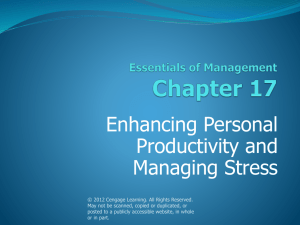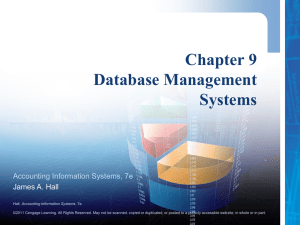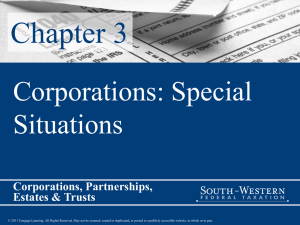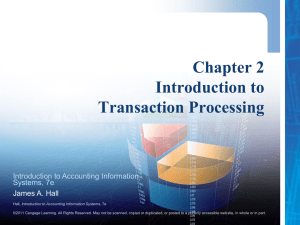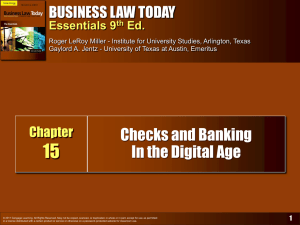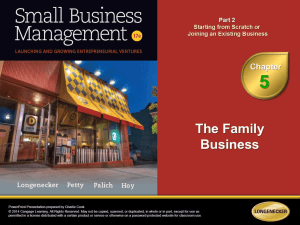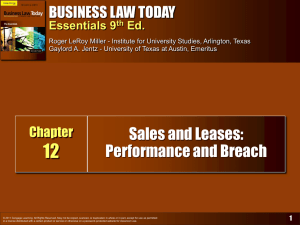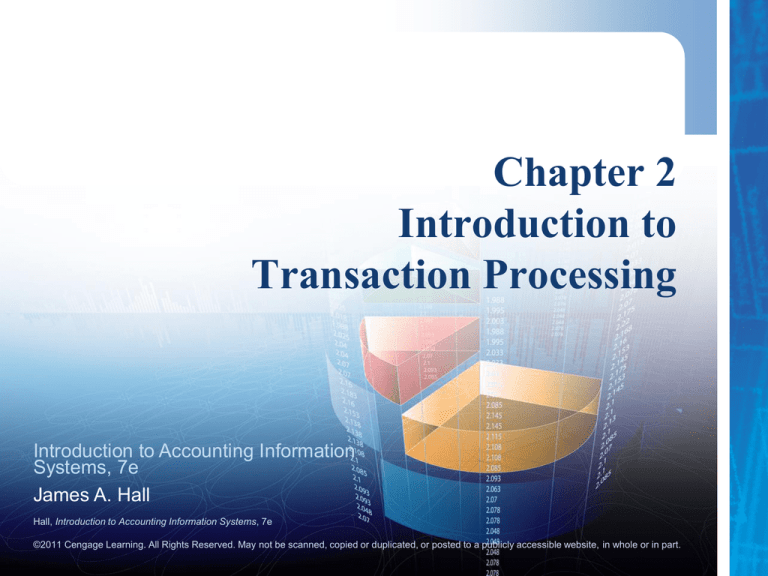
Chapter 2
Introduction to
Transaction Processing
Introduction to Accounting Information
Systems, 7e
James A. Hall
Hall, Introduction to Accounting Information Systems, 7e
©2011 Cengage Learning. All Rights Reserved. May not be scanned, copied or duplicated, or posted to a publicly accessible website, in whole or in part.
Revision:
TPS consists of three subsystems:
Revenue
Expenditure
Conversion cycle
Common characteristics:
Capture financial transactions
Record effects of transactions on accounting rec
Provide info to users to support day-to-day
activities
Hall, Introduction to Accounting Information Systems, 7e
2
©2011 Cengage Learning. All Rights Reserved. May not be scanned, copied or duplicated, or posted to a publicly accessible website, in whole or in part.
Overview: Five major sections
Overview of transaction processing
Objectives of the three cycles and roles
Relationship among accounting records
forming an audit trail
Documentation techniques
Techniques used to represent systems
CB systems: batch and real-time
Coding schemes
Hall, Introduction to Accounting Information Systems, 7e
3
©2011 Cengage Learning. All Rights Reserved. May not be scanned, copied or duplicated, or posted to a publicly accessible website, in whole or in part.
Learning Outcomes:
Understand the broad objectives of transaction cycles.
Recognize the types of transactions processed by each
of the three transaction cycles
Know the basic accounting records used in TPS.
Understand the relationship between the traditional
accounting records and their magnetic equivalents.
Be familiar with documentation techniques.
Understand the differences between batch and real-time
processing and the impact of these technologies on
transaction processing.
Be familiar with data coding schemes used in AIS.
Hall, Introduction to Accounting Information Systems, 7e
4
©2011 Cengage Learning. All Rights Reserved. May not be scanned, copied or duplicated, or posted to a publicly accessible website, in whole or in part.
Self-study:
Page 14 (1) – 10 of study guide!!
Why?
It will assist you in understanding the work in the
book, p 44 – 51
Hall, Introduction to Accounting Information Systems, 7e
5
©2011 Cengage Learning. All Rights Reserved. May not be scanned, copied or duplicated, or posted to a publicly accessible website, in whole or in part.
A Financial Transaction is...
an economic event that affects the assets and
equities of the firm, is reflected in its accounts,
and is measured in monetary terms.
similar types of transactions are grouped
together into three transaction cycles:
the expenditure cycle
the conversion cycle
the revenue cycle
Hall, Introduction to Accounting Information Systems, 7e
6
©2011 Cengage Learning. All Rights Reserved. May not be scanned, copied or duplicated, or posted to a publicly accessible website, in whole or in part.
An AIS
Hall, Introduction to Accounting Information Systems, 7e
7
©2011 Cengage Learning. All Rights Reserved. May not be scanned, copied or duplicated, or posted to a publicly accessible website, in whole or in part.
Examples:
External transactions:
Sale of goods/services, purchase of inventory,
discharge of financial obligations, receipt of cash
Internal:
Depreciation of fixed assets, application of labor,
raw material, overhead of production process,
transfer of inventory from one department to
another
Hall, Introduction to Accounting Information Systems, 7e
8
©2011 Cengage Learning. All Rights Reserved. May not be scanned, copied or duplicated, or posted to a publicly accessible website, in whole or in part.
Relationship between Transaction Cycles
Figure 2-1
Hall, Introduction to Accounting Information Systems, 7e
9
©2011 Cengage Learning. All Rights Reserved. May not be scanned, copied or duplicated, or posted to a publicly accessible website, in whole or in part.
Expenditure Cycle:
Business activities begin
Acquisition of materials, property, labor in the
exchange of cash
Usually the relationship is based on a credit rel.
The disbursement of cash takes place after the
receipt of goods
Transaction has two parts
Physical: acquisition of goods
Financial: cash disbursement
Hall, Introduction to Accounting Information Systems, 7e
10
©2011 Cengage Learning. All Rights Reserved. May not be scanned, copied or duplicated, or posted to a publicly accessible website, in whole or in part.
Sub systems, p43
Identify IPO components with each subsystem
Purchase/accounts payable:
Cash disbursements:
Payroll system:
Fixed asset system:
Hall, Introduction to Accounting Information Systems, 7e
11
©2011 Cengage Learning. All Rights Reserved. May not be scanned, copied or duplicated, or posted to a publicly accessible website, in whole or in part.
Each Cycle has Two Primary Subsystems
Expenditure Cycle: time lag between the two due to credit
relations with suppliers:
physical component (acquisition of goods)
financial component (cash disbursements to the supplier)
Conversion Cycle :
the production system (planning, scheduling, and control
of the physical product through the manufacturing process)
the cost accounting system (monitors the flow of cost
information related to production)
Revenue Cycle: time lag between the two due to credit
relations with customers :
physical component (sales order processing)
financial component (cash receipts)
Hall, Introduction to Accounting Information Systems, 7e
12
©2011 Cengage Learning. All Rights Reserved. May not be scanned, copied or duplicated, or posted to a publicly accessible website, in whole or in part.
Accounting Records:
Manual system:
Documents
Journals
Ledgers
Audit trail
CB Systems
Master file
Transaction file
Reference file
Hall, Introduction to Accounting Information Systems, 7e
13
©2011 Cengage Learning. All Rights Reserved. May not be scanned, copied or duplicated, or posted to a publicly accessible website, in whole or in part.
Manual system: Documents
Document: Evidence of an economic event
Source Documents - used to capture and
formalize transaction data needed for
transaction processing
Product Documents - the result of
transaction processing
Turnaround Documents - a product
document of one system that becomes a
source document for another system
Hall, Introduction to Accounting Information Systems, 7e
14
©2011 Cengage Learning. All Rights Reserved. May not be scanned, copied or duplicated, or posted to a publicly accessible website, in whole or in part.
Source doc Product Turn:
Example: sales cause the sales clerk to
prepare a multiple sales order, which is the
evidence that a sale occurred
Copies of this source document is entered
into the sale system
Convey info to billing, shipping, AR etc.
Specific activities are triggered
Customer’s bill is a product document of the
sales system. Bill consists of a remittance
advice + payment cash receipts system
Hall, Introduction to Accounting Information Systems, 7e
15
©2011 Cengage Learning. All Rights Reserved. May not be scanned, copied or duplicated, or posted to a publicly accessible website, in whole or in part.
Manual System (cont.):
Journals - a record of chronological entry
special journals - specific classes of transactions that
occur in high frequency
general journal - nonrecurring, infrequent, and
dissimilar transactions
Ledger - a book of financial accounts
general ledger - shows activity for each account listed
on the chart of accounts
subsidiary ledger - shows activity by detail for each
account type
Hall, Introduction to Accounting Information Systems, 7e
16
©2011 Cengage Learning. All Rights Reserved. May not be scanned, copied or duplicated, or posted to a publicly accessible website, in whole or in part.
Flow of Information from Economic
Event Into the General Ledger
Figure 2-8
Hall, Introduction to Accounting Information Systems, 7e
17
©2011 Cengage Learning. All Rights Reserved. May not be scanned, copied or duplicated, or posted to a publicly accessible website, in whole or in part.
Computer-Based Systems
The audit trail is less observable in computerbased systems than traditional manual systems.
The data entry and computer programs are the
physical trail.
The data are stored in magnetic files.
Hall, Introduction to Accounting Information Systems, 7e
18
©2011 Cengage Learning. All Rights Reserved. May not be scanned, copied or duplicated, or posted to a publicly accessible website, in whole or in part.
Computer Files
Master File - generally contains account data
(e.g., general ledger and subsidiary file)
Transaction File - a temporary file containing
transactions since the last update
Reference File - contains relatively constant
information used in processing (e.g., tax
tables, customer addresses)
Archive File - contains past transactions for
reference purposes
Hall, Introduction to Accounting Information Systems, 7e
19
©2011 Cengage Learning. All Rights Reserved. May not be scanned, copied or duplicated, or posted to a publicly accessible website, in whole or in part.
Accounting Records in a Computer-Based System
EXPLANATION OF
STEPS IN FIGURE:
Figure 2-11
1. Compare the AR
balance in the balance
sheet with the master file
AR control account
balance.
2. Reconcile the AR
control figure with the AR
subsidiary account total.
3. Select a sample of
update entries made to
accounts in the AR
subsidiary ledger
and trace these to
transactions in the sales
journal (archive file).
4. From these journal
entries, identify source
documents that can be
pulled from their files and
verified. If necessary,
confirm these source
documents by contacting
the customers.
Hall, Introduction to Accounting Information Systems, 7e
20
©2011 Cengage Learning. All Rights Reserved. May not be scanned, copied or duplicated, or posted to a publicly accessible website, in whole or in part.
Audit Trail
Source
Document
Journal
Financial
Statements
General
Ledger
General
Ledger
Journal
Financial
Statements
Source
Document
Accountants should be able to trace in both directions.
Sampling and confirmation are two common techniques.
Hall, Introduction to Accounting Information Systems, 7e
21
©2011 Cengage Learning. All Rights Reserved. May not be scanned, copied or duplicated, or posted to a publicly accessible website, in whole or in part.
Example of Tracing an Audit Trail
Verifying Accounts Receivable
Accounts Receivable Control Account-General Ledger
Accounts Receivable Subsidiary Ledger
(sum of all customers’ receivables)
Physical
Financial
Sales Journal
Cash Receipts Journal
Sales Order
Shipping Notice
Deposit Slip
Remittance Advice
Hall, Introduction to Accounting Information Systems, 7e
22
©2011 Cengage Learning. All Rights Reserved. May not be scanned, copied or duplicated, or posted to a publicly accessible website, in whole or in part.
Documentation Techniques
Documentation in a CB environment is
necessary for many reasons.
Five common documentation techniques:
Entity Relationship Diagram
Data Flow Diagrams
Document Flowcharts
System Flowcharts
Program Flowcharts
Hall, Introduction to Accounting Information Systems, 7e
23
©2011 Cengage Learning. All Rights Reserved. May not be scanned, copied or duplicated, or posted to a publicly accessible website, in whole or in part.
Entity Relationship Diagram (ERD)
A documentation technique to represent
the relationship between entities in a
system.
The REA model version of ERD is widely
used in AIS. REA uses 3 types of entities:
resources (cash, raw materials)
events (release of raw materials into the
production process)
agents (inventory control clerk, vendor,
production worker)
Hall, Introduction to Accounting Information Systems, 7e
24
©2011 Cengage Learning. All Rights Reserved. May not be scanned, copied or duplicated, or posted to a publicly accessible website, in whole or in part.
Cardinalities
Represent the numerical mapping
between entities:
one-to-one
one-to-many
many-to-many
Hall, Introduction to Accounting Information Systems, 7e
25
©2011 Cengage Learning. All Rights Reserved. May not be scanned, copied or duplicated, or posted to a publicly accessible website, in whole or in part.
Cardinalities
Entity
Salesperson
Relationship
1
1
Customer
Vendor
M
Assigned
Places
Supply
Entity
1
M
M
Car
Type
Order
Inventory
Hall, Introduction to Accounting Information Systems, 7e
26
©2011 Cengage Learning. All Rights Reserved. May not be scanned, copied or duplicated, or posted to a publicly accessible website, in whole or in part.
Data Flow Diagrams (DFD)…
use symbols to represent the processes, data
sources, data flows, and entities in a system
represent the logical elements of the system
do not represent the physical system
Hall, Introduction to Accounting Information Systems, 7e
27
©2011 Cengage Learning. All Rights Reserved. May not be scanned, copied or duplicated, or posted to a publicly accessible website, in whole or in part.
Data Flow Diagram Symbols
Entity
Name
Data Store
Name
N
Process
Description
Direction of
data flow
Figure 2-12
Hall, Introduction to Accounting Information Systems, 7e
28
©2011 Cengage Learning. All Rights Reserved. May not be scanned, copied or duplicated, or posted to a publicly accessible website, in whole or in part.
System Flowcharts…
illustrate the relationship among processes
and the documents that flow between
them
contain more details than data flow
diagrams
clearly depict the separation of functions in
a system
Hall, Introduction to Accounting Information Systems, 7e
29
©2011 Cengage Learning. All Rights Reserved. May not be scanned, copied or duplicated, or posted to a publicly accessible website, in whole or in part.
Symbol Set for Representing
Manual Procedures
Terminal showing source
or destination of documents
and reports
Calculated batch total
Source document or
report
On-page connector
Manual operation
Off-page connector
File for storing source
documents and
reports
Accounting records
(journals, registers,
logs, ledgers)
Description of process
or comments
Document flowline
Figure 2-17
Hall, Introduction to Accounting Information Systems, 7e
30
©2011 Cengage Learning. All Rights Reserved. May not be scanned, copied or duplicated, or posted to a publicly accessible website, in whole or in part.
Flowchart Showing Stated Fact I Translated
into Visual Symbols
Sales Department
Credit Department
Warehouse
Shipping Department
Customer
Customer
Order
Prepare
Sales
Orders
Sales
OrderSales
#1
Order #1
Sales
Order #1
Sales
Order #1
Figure 2-18
Hall, Introduction to Accounting Information Systems, 7e
31
©2011 Cengage Learning. All Rights Reserved. May not be scanned, copied or duplicated, or posted to a publicly accessible website, in whole or in part.
Flowchart Showing All Stated Facts
Translated into Visual Symbols
Figure 2-20
Hall, Introduction to Accounting Information Systems, 7e
32
©2011 Cengage Learning. All Rights Reserved. May not be scanned, copied or duplicated, or posted to a publicly accessible website, in whole or in part.
System Flowcharts…
are used to represent the relationship
between the key elements--input sources,
programs, and output products--of computer
systems
depict the type of media being used (paper,
magnetic tape, magnetic disks, and
terminals)
in practice, not much difference between
document and system flowcharts
Hall, Introduction to Accounting Information Systems, 7e
33
©2011 Cengage Learning. All Rights Reserved. May not be scanned, copied or duplicated, or posted to a publicly accessible website, in whole or in part.
Symbol Set for Representing Computer
Processes
Hard copy
Computer process
Terminal input/
output device
Process flow
Direct access storage
device
Real-time
(online)
connection
Magnetic tape
Video display
device
Figure 2-21
Hall, Introduction to Accounting Information Systems, 7e
34
©2011 Cengage Learning. All Rights Reserved. May not be scanned, copied or duplicated, or posted to a publicly accessible website, in whole or in part.
Flowchart Showing Translation of
Facts 1, 2, and 3 into Visual Symbols
Hall, Introduction to Accounting Information Systems, 7e
35
Figure 2-22
©2011 Cengage Learning. All Rights Reserved. May not be scanned, copied or duplicated, or posted to a publicly accessible website, in whole or in part.
Flowchart Showing All Facts Translated
into Visual Symbols
Hall, Introduction to Accounting Information Systems, 7e
Figure 2-23
©2011 Cengage Learning. All Rights Reserved. May not be scanned, copied or duplicated, or posted to a publicly accessible website, in whole or in part.
36
Program Flowcharts…
illustrate the logic used in programs
Program Flowchart Symbols
Logical process
Terminal start or
end operation
Input/output
operation
Decision
Flow of logical
process
Figure 2-24
Hall, Introduction to Accounting Information Systems, 7e
37
©2011 Cengage Learning. All Rights Reserved. May not be scanned, copied or duplicated, or posted to a publicly accessible website, in whole or in part.
Modern Systems versus Legacy Systems
Modern systems characteristics:
client-server based and process transactions in real time
use relational database tables
have high degree of process integration and data sharing
some are mainframe based and use batch processing
Some firms employ legacy systems for certain aspects
of their data processing.
Accountants need to understand legacy systems.
Legacy systems characteristics:
mainframe-based applications
batch oriented
early legacy systems use flat files for data storage
later legacy systems use hierarchical and network databases
data storage systems promote a single-user environment that
discourages information integration
Hall, Introduction to Accounting Information Systems, 7e
38
©2011 Cengage Learning. All Rights Reserved. May not be scanned, copied or duplicated, or posted to a publicly accessible website, in whole or in part.
Record Structures for Sales, Inventory, and
Accounts Receivable Files
Figure 2-28
Hall, Introduction to Accounting Information Systems, 7e
39
©2011 Cengage Learning. All Rights Reserved. May not be scanned, copied or duplicated, or posted to a publicly accessible website, in whole or in part.
Database Backup Procedures
•Destructive updates leave no backup.
•To preserve adequate records, backup procedures must be
implemented, as shown below:
The master file being updated is copied as a backup.
A recovery program uses the backup to create a preupdate version of the master file.
Figure 2-30
Hall, Introduction to Accounting Information Systems, 7e
40
©2011 Cengage Learning. All Rights Reserved. May not be scanned, copied or duplicated, or posted to a publicly accessible website, in whole or in part.
Computer-Based Accounting
Systems
Two broad classes of systems:
batch systems
real-time systems
Hall, Introduction to Accounting Information Systems, 7e
©2011 Cengage Learning. All Rights Reserved. May not be scanned, copied or duplicated, or posted to a publicly accessible website, in whole or in part.
Batch Processing
A batch is a group of similar transactions that are
accumulated over time and then processed
together.
The transactions must be independent of one
another during the time period over which the
transactions are accumulated in order for batch
processing to be appropriate.
A time lag exists between the event and the
processing.
Hall, Introduction to Accounting Information Systems, 7e
42
©2011 Cengage Learning. All Rights Reserved. May not be scanned, copied or duplicated, or posted to a publicly accessible website, in whole or in part.
Batch Processing/Sequential File
Sales
Orders
Unedited
Transactions
Keying
correct errors and
resubmit
Errors
catches clerical errors
Edit
Run
Edited
Transactions
rearranges the transaction data by
key field so that it is in the same
sequence as the master file
Sort
Run
Transactions
Old Master
(father)
AR
Update
Run
New Master
(son)
changes the values in the master
file to reflect the transactions that
have occurred
AR
Transactions (eventually transferred to an archive file)
Hall, Introduction to Accounting Information Systems, 7e
43
©2011 Cengage Learning. All Rights Reserved. May not be scanned, copied or duplicated, or posted to a publicly accessible website, in whole or in part.
Steps in Batch Processing/Sequential File
Keystroke - source documents are transcribed by clerks to
magnetic tape for processing later
Edit Run - identifies clerical errors in the batch and places
them into an error file
Sort Run - places the transaction file in the same order as the
master file using a primary key
Update Run - changes the value of appropriate fields in the
master file to reflect the transaction
Backup Procedure - the original master continues to exist
and a new master file is created
Hall, Introduction to Accounting Information Systems, 7e
44
©2011 Cengage Learning. All Rights Reserved. May not be scanned, copied or duplicated, or posted to a publicly accessible website, in whole or in part.
Advantages of Batch Processing
Organizations can increase efficiency by
grouping large numbers of transactions into
batches rather than processing each event
separately.
Batch processing provides control over the
transaction process via control figures.
Hall, Introduction to Accounting Information Systems, 7e
45
©2011 Cengage Learning. All Rights Reserved. May not be scanned, copied or duplicated, or posted to a publicly accessible website, in whole or in part.
Real-Time Systems…
process transactions individually at the
moment the economic event occurs
have no time lag between the economic event
and the processing
generally require greater resources than batch
processing since they require dedicated
processing capacity; however, these cost
differentials are decreasing
oftentimes have longer systems development
time
Hall, Introduction to Accounting Information Systems, 7e
46
©2011 Cengage Learning. All Rights Reserved. May not be scanned, copied or duplicated, or posted to a publicly accessible website, in whole or in part.
Hall, Introduction to Accounting Information Systems, 7e
47
©2011 Cengage Learning. All Rights Reserved. May not be scanned, copied or duplicated, or posted to a publicly accessible website, in whole or in part.
Why Do So Many AIS Use Batch
Processing?
AIS processing is characterized by high-volume,
independent transactions, such are recording
cash receipts checks received in the mail.
The processing of such high-volume checks can
be done during an off-peak computer time.
This is one reason why batch processing maybe
done using real-time data collection.
Hall, Introduction to Accounting Information Systems, 7e
48
©2011 Cengage Learning. All Rights Reserved. May not be scanned, copied or duplicated, or posted to a publicly accessible website, in whole or in part.
Uses of Coding in AIS
Concisely represent large amounts of complex
information that would otherwise be
unmanageable
Provide a means of accountability over the
completeness of the transactions processed
Identify unique transactions and accounts
within a file
Support the audit function by providing an
effective audit trail
Hall, Introduction to Accounting Information Systems, 7e
49
©2011 Cengage Learning. All Rights Reserved. May not be scanned, copied or duplicated, or posted to a publicly accessible website, in whole or in part.
Sequential Codes
Represent items in sequential order
Used to prenumber source documents
Track each transaction processed
Identify any out-of-sequence documents
Disadvantages:
arbitrary information
hard to make changes and insertions
Hall, Introduction to Accounting Information Systems, 7e
50
©2011 Cengage Learning. All Rights Reserved. May not be scanned, copied or duplicated, or posted to a publicly accessible website, in whole or in part.
Block Codes
Represent whole classes by assigning each
class a specific range within the coding scheme
Used for chart of accounts
The basis of the general ledger
Allows for the easy insertion of new codes
within a block
Don’t have to reorganize the coding structure
Disadvantage:
arbitrary information
Hall, Introduction to Accounting Information Systems, 7e
51
©2011 Cengage Learning. All Rights Reserved. May not be scanned, copied or duplicated, or posted to a publicly accessible website, in whole or in part.
Group Codes
Represent complex items or events involving
two or more pieces of data using fields with
specific meaning
For example, a coding scheme for tracking
sales might be 04-09-476214-99, meaning:
Store Number
04
Dept. Number
09
Item Number
476214
Salesperson
99
• Disadvantages:
– arbitrary information
– overused
Hall, Introduction to Accounting Information Systems, 7e
52
©2011 Cengage Learning. All Rights Reserved. May not be scanned, copied or duplicated, or posted to a publicly accessible website, in whole or in part.
Alphabetic Codes
Used for many of the same purposes as
numeric codes
Can be assigned sequentially or used in
block and group coding techniques
May be used to represent large numbers of
items
Can represents up to 26 variations per field
Disadvantage:
arbitrary information
Hall, Introduction to Accounting Information Systems, 7e
53
©2011 Cengage Learning. All Rights Reserved. May not be scanned, copied or duplicated, or posted to a publicly accessible website, in whole or in part.
Mnemonic Codes
Alphabetic characters used as
abbreviations, acronyms, and other types
of combinations
Do not require users to memorize the
meaning since the code itself is
informative – and not arbitrary
NY = New York
Disadvantages:
limited usability and availability
Hall, Introduction to Accounting Information Systems, 7e
54
©2011 Cengage Learning. All Rights Reserved. May not be scanned, copied or duplicated, or posted to a publicly accessible website, in whole or in part.


